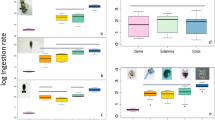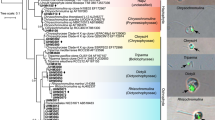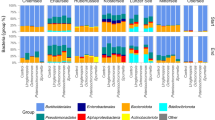Abstract
THE potential importance of bacteria in freshwater planktonic food webs is recognised1, but the mechanisms of their incorporation are not fully known. Most planktonic bacteria are not attached to particles and are less than 1 µm (refs 2–4) in size—a range inefficiently filtered by crustacean zooplankton5. Daphnia and Diaptomus feed at lower rates on free living bacteria than on algae6,7. Bacterial food sources have been used with varying degrees of success to culture zooplankton8–11. These variations may be due to the unnatural range of concentrations used and the uncontrolled effects of different culture media, laboratory strains and the degree of accessibility to the zooplankton (because of cell clumping and sedimentation). Ciliate protozoan microzooplankton may be important intermediaries which transform ultrafine organic matter, including bacteria, into a particle size range readily available to crustacean zooplankton. Here we present evidence that ciliates are cropped by crustacean zooplankton in the natural environment. We have also measured feeding, filtering, and assimilation rates of Daphnia magna on both a large and small ciliate in the laboratory and have observed feeding behaviour directly. Dissolved organic carbon, bacteria, ciliate protozoans and crustacean zooplankton may represent a significant pathway of carbon flow in the freshwater plankton.
This is a preview of subscription content, access via your institution
Access options
Subscribe to this journal
Receive 51 print issues and online access
$199.00 per year
only $3.90 per issue
Buy this article
- Purchase on Springer Link
- Instant access to full article PDF
Prices may be subject to local taxes which are calculated during checkout
Similar content being viewed by others
References
Overbeck, J. Mitt. Internat. Verein. Limnol. 20, 198–228 (1974).
Hobbie, J. E., Daley, R. J. & Jasper, S. Appl. environ. Microbiol. 33, 1225–1228 (1977).
Wiebe, W. J. & Pomeroy, L. R. Mem. Inst. Ital. Idrobiol. 29, Suppl. 325–352 (1972).
Azam, F. & Hodson, R. E. Limnol. Oceanogr. 22, 492–501 (1977).
Jorgensen, C. B. A. Rev. Physiol. 37, 57–79 (1975).
Malovitskaya, L. M. & Sorokin, Y. I. Tr. Inst. Biol. Vodokhr. 4, 262–272 (1961).
Peterson, B. J., Hobbie, J. E. & Haney, J. F. Limnol. Oceanogr. 23, 1039–1044 (1978).
Tezuka, Y. Jap. J. Ecol. 21, 127–134 (1971).
Tezuka, Y. Int. Revue ges. Hydrobiol. 59, 31–37 (1974).
Seki, H. Mem. Inst. Ital. Idrobiol. 29, Suppl., 245–259 (1972).
Heinle, D. R., Harris, R. P., Ustach, J. F. & Flemer, D. A. Mar. Biol. 40, 341–353 (1977).
Fenchel, T. Ophelia 5, 73–121 (1968).
Curds, C. R. & Cockburn, A. J. gen. Microbiol. 54, 343–358 (1968).
Porter, K. G. Nature 244, 179–180 (1973).
Berk, S. G., Brownlee, D. C., Heinle, D. R., Kling, H. J. & Colwell, R. R. Microb. Ecol. 4, 27–40 (1977).
Allen, S. L. & Nerad, T. A. J. Protozool. 25, 134–139 (1978).
Porter, K. G. Science 192, 1332–1334 (1976).
Dagg, M. J. Ecology 55, 903–906 (1974).
Porter, K. G. Am. Sci. 65, 159–170 (1977).
Burns, C. Limnol. Oceanogr. 13, 675–678 (1968).
Hamilton, R. D. & Preslan, J. E. J. exp. mar. Biol. Ecol. 5, 94–104 (1970).
Berk, S. G., Colwell, R. R. & Small, E. B. Trans. Am. microsc. Soc. 95, 514–520 (1976).
Sorokin, Y. I. & Paveljeva, E. B. Hydrobiologia 40, 519–552 (1972).
Hutchinson, G. E. A Treatise on Limnology Vol. 2 (Wiley, New York, 1967).
Author information
Authors and Affiliations
Rights and permissions
About this article
Cite this article
PORTER, K., PACE, M. & BATTEY, J. Ciliate protozoans as links in freshwater planktonic food chains. Nature 277, 563–565 (1979). https://doi.org/10.1038/277563a0
Received:
Accepted:
Published:
Issue Date:
DOI: https://doi.org/10.1038/277563a0
This article is cited by
-
Influence of Ecological Multiparameters on Facets of β-Diversity of Freshwater Plankton Ciliates
Microbial Ecology (2024)
-
Top-down control of planktonic ciliates by microcrustacean predators is stronger in lakes than in the ocean
Scientific Reports (2022)
-
Insight into the role of cyanobacterial bloom in the trophic link between ciliates and predatory copepods
Hydrobiologia (2022)
-
Synthesis of CdS1-XSeX quantum dots in a protozoa Tetrahymena pyriformis
Applied Microbiology and Biotechnology (2019)
-
What Underpins the Trophic Networks of the Plankton in Shallow Oxbow Lakes?
Microbial Ecology (2017)
Comments
By submitting a comment you agree to abide by our Terms and Community Guidelines. If you find something abusive or that does not comply with our terms or guidelines please flag it as inappropriate.



